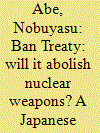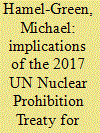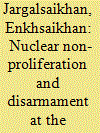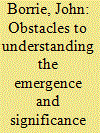|
|
|
Sort Order |
|
|
|
Items / Page
|
|
|
|
|
|
|
| Srl | Item |
| 1 |
ID:
161340


|
|
|
|
|
| Summary/Abstract |
In so far as the nuclear-weapons possessors do not accept the Ban Treaty, practically it will not reduce nuclear weapons nor abolish them as a matter of law. However, if the treaty is accepted by an overwhelming majority of states, it will significantly strengthen the norm against the nuclear weapons. A norm binds everybody irrespective of legal acceptance of a treaty. Thus, it exposes any violator to the risk of international punishment. The Ban Treaty will help bring the movement towards nuclear abolition forward and reduce incentives to own nuclear weapons. The international humanitarian law that was the main basis for the Ban Treaty needs to be upheld firmly. The set of norms under international humanitarian law will serve to limit the justifiable cases where nuclear weapons can ever be used. The Non-Proliferation Treaty and the efforts to prevent nuclear proliferation must be sustained even after the Ban Treaty comes into force.
|
|
|
|
|
|
|
|
|
|
|
|
|
|
|
|
| 2 |
ID:
161331


|
|
|
|
|
| Summary/Abstract |
The humanitarian initiative for nuclear disarmament has challenged and transformed global nuclear politics. Aimed at delegitimising nuclear weapons as acceptable instruments of statecraft, the initiative has been backed by many civil society organisations and most non-nuclear-weapon states. The nuclear-weapon states, however, have opposed the initiative, accusing it of undermining the Nuclear Non-Proliferation Treaty and destabilising nuclear politics. Conceptualising a ‘diplomacy of resistance’, this article positions the humanitarian initiative as a transnational social movement and traces its development through practices of resistance and counter-resistance. Drawing on Robert Cox’s conception of resistance as counter-hegemonic and Michael Barnett and Raymond Duvall’s taxonomy of power, the article explores the nexus of power and resistance in global nuclear politics. We explain the humanitarian movement’s specific aims and practices as a function of its champion’s relative political weakness vis-à-vis the nuclear-weapon states. The movement’s coherence and effectiveness, in turn, was fostered by a coalitional logic that allowed different identities of resistance to be steered towards a nuclear ban treaty within the UN’s institutional framework.
|
|
|
|
|
|
|
|
|
|
|
|
|
|
|
|
| 3 |
ID:
161337


|
|
|
|
|
| Summary/Abstract |
The process to negotiate and adopt the Treaty on the Prohibition of Nuclear Weapons has already had significant impacts on nuclear weapon law, politics, economics, and social and academic discourse. While the full range of effects of the nuclear ban is not yet known, economic divestment and changes to nuclear weapon discourse are well underway. This article examines how some of the expectations and hopes of the Treaty’s advocates are being fulfilled, and what else might be possible.
|
|
|
|
|
|
|
|
|
|
|
|
|
|
|
|
| 4 |
ID:
161335


|
|
|
|
|
| Summary/Abstract |
The 2017 Nuclear Weapon Prohibition Treaty preamble reaffirmed the role of regional nuclear weapon free zones (NWFZs) in enhancing regional peace and security and in contributing to wider nuclear disarmament objectives. Existing such zones in many regions, including Latin America, South Pacific, Southeast Asia, Africa, Central Asia and Mongolia, have played significant roles in both preventing or reversing nuclear proliferation, assisting in the delegitimization of nuclear weapons as part of regional security arrangements, and securing binding negative security guarantees from nuclear weapon states (a feature absent in the NPT). At the same time, the new Prohibition Treaty contains important provisions that may require strengthening of existing NWFZs and consideration for incorporation in new such zones. The article examines particular needs for strengthening existing and proposed NWFZs, particularly in relation to the control over nuclear weapons, threats of nuclear weapon use, assistance in engaging in prohibited nuclear weapon activities, and obligations to provide victim assistance and environmental remediation in areas affected by nuclear testing.
|
|
|
|
|
|
|
|
|
|
|
|
|
|
|
|
| 5 |
ID:
161334


|
|
|
|
|
| Summary/Abstract |
The Treaty on the Prohibition of Nuclear Weapons calls for states to meet regularly to consider measures for the verified, time-bound and irreversible elimination of nuclear weapon programs. Key to this effort is mapping a comprehensive set of nuclear weapon program indicators and further developing international capacity to monitor them. Distinct from the deadlocked Conference on Disarmament, this new forum will have an opportunity to examine and elaborate disarmament verification concepts. One relevant concept is an international monitoring system for nuclear disarmament and nonproliferation verification (NDN-IMS), elaborated from a proposal most recently noted by the United Nations Open-ended Working Group (A/71/371). As a flexible framework, an NDN-IMS, could help unite diverse technologies and mechanisms around the purpose of disarmament verification in ways that support the existing nonproliferation regime and the Nuclear Nonproliferation Treaty. Elements could include satellite imagery from new constellations, wide area environmental sampling, and civil society reporting.
|
|
|
|
|
|
|
|
|
|
|
|
|
|
|
|
| 6 |
ID:
161333


|
|
|
|
|
| Summary/Abstract |
Reframing nuclear weapons as a humanitarian issue revolutionised the diplomatic debate surrounding them, and in 2017, 122 countries adopted the Treaty on the Prohibition of Nuclear Weapons (TPNW). The humanitarian approach to disarmament provided inspiration for this historic achievement. While traditional disarmament aims primarily to protect state security, humanitarian disarmament strives to end human suffering. This article examines the TPNW as the latest step in humanitarian disarmament. Through a close analysis of process and text, it finds that humanitarian disarmament served as a catalyst to and model for the TPNW’s negotiations and shaped its purpose and provisions. The article also shows how the humanitarian underpinnings of the TPNW allowed it to transform nuclear disarmament and how the new treaty strengthened humanitarian disarmament in return.
|
|
|
|
|
|
|
|
|
|
|
|
|
|
|
|
| 7 |
ID:
161336


|
|
|
|
|
| Summary/Abstract |
The Treaty on the Prohibition of Nuclear Weapons is historic not only in its substance but in the process of its development. It was led by states free from nuclear weapons; based on humanitarian evidence and imperatives; involved civil society, hibakusha and survivors of nuclear testing to a degree that is unprecedented in the nuclear field; and is the first nuclear disarmament treaty negotiated through the UN General Assembly, with the process proving both effective and efficient, despite fierce opposition from a number of nuclear-armed states, whose lack of commitment to nuclear disarmament was made very plain. The International Campaign to Abolish Nuclear Weapons (ICAN) became the main civil society partner for governments leading and supporting the ‘Humanitarian Initiative’ which resulted in the negotiations. ICAN’s principles, strategy and work are discussed in the context of the ‘stigmatise – prohibit – eliminate’ approach which has proven effective for other inhumane and indiscriminate weapons.
|
|
|
|
|
|
|
|
|
|
|
|
|
|
|
|
| 8 |
ID:
161338


|
|
|
|
|
| Summary/Abstract |
Adoption of the Treaty on the Prohibition of Nuclear Weapons in July 2017 was a major event in the history of seven decades of policies and campaigns for non-proliferation and nuclear disarmament. In this, the role of non-nuclear weapon states (NNWSs) should not be underestimated. However, the treaty’s adoption would require bringing it into force by making use of the political momentum thus far generated. This will not be easy to do due to the position of the nuclear-weapon states and their allies. Hence, continued mutual support and cooperation among the NNWSs is vital, and working with the states under 'nuclear umbrella' will need to be pursued. The article also underlines the continued role of the civil society, both national and international, of nuclear weapon-free zones (NWFZs), and even of individual states contributing to practical nuclear disarmament. As an example of the latter, it examines Mongolia’s role and the challenges it faced when promoting its nuclear weapon-free status policy. The experience underlines the importance of greater understanding of the legitimate interests of each other and willingness to jointly address the issues of common concern, of working patiently in a low-key manner rather than pursuing immediate gains or headline-grabbing effects. The P5 joint declaration of 2012 regarding Mongolia’s status rules out using the country in future regional geopolitical rivalries and as such contributes to greater predictability, stability and confidence. The article also suggests the need for a renewed look at NWFZs from the perspective of twenty-first century technical developments and requirements.
|
|
|
|
|
|
|
|
|
|
|
|
|
|
|
|
| 9 |
ID:
161330


|
|
|
|
|
| Summary/Abstract |
This article examines the emergence of the UN Treaty on the Prohibition of Nuclear Weapons from a critical perspective, including how and to what degree efforts to alter states’ framing of nuclear weapons was a factor in the treaty's emergence and negotiation. It examines the so-called humanitarian initiative on the consequences of nuclear weapons, the activities of the International Campaign to Abolish Nuclear Weapons and the roles played by transnational institutions like the United Nations and the Red Cross Movement. In view of this case, lessons and limits on transnational advocacy network models of norm emergence are highlighted. In order to contribute to the process of better understanding the emergence and significance of the prohibition treaty process based on research, some areas are identified in which evidence gathering and theorizing are needed.
|
|
|
|
|
|
|
|
|
|
|
|
|
|
|
|
| 10 |
ID:
161332


|
|
|
|
|
| Summary/Abstract |
The United Nations Treaty on the Prohibition of Nuclear Weapons presents complex challenges, including issues of verification and security. Verifying the transformation to a nuclear-weapon-free world (NWFW) is an adaptive, multi-stage process, involving various mechanisms and tasks for nuclear and non-nuclear weapon States, and monitoring a wide range of items and activities for increasing or decreasing nuclear weapons capability. Whether States find the Treaty verifiable depends on the available capabilities, but also on political assumptions and requirements. Verification plays an important role in the transformation towards a NWFW to diminish the role of nuclear weapons in a hostile environment where uncertainties are seen as threatening. Verification also helps to establish a viable international security landscape based on cooperation and trust that is able to address the complex implementation issues of nuclear weapons prohibition and elimination.
|
|
|
|
|
|
|
|
|
|
|
|
|
|
|
|
| 11 |
ID:
161339


|
|
|
|
|
| Summary/Abstract |
The year 2017 will go down in history as a key turning point in anti-nuclear activism. The Nobel Peace Prize was awarded to ICAN and a ban treaty was adopted by an overwhelming majority of the world’s nations. For young people, never before has there been such momentum for a nuclear-free world. Excited by this progress and wanting to build further momentum, this brief piece provides insights about the importance of feminist analysis and the role that young people are playing by providing a snapshot of anti-nuclear campaigns. By drawing on the perspectives of several young activists, it argues for, and details why the perspectives of young people are significant, and outlines various strengths and strategies of engaging youth, along with complexities and challenges. Overall, this piece provides a timely analysis of the powerful role that young people can play in anti-nuclear activism.
|
|
|
|
|
|
|
|
|
|
|
|
|
|
|
|
|
|
|
|
|